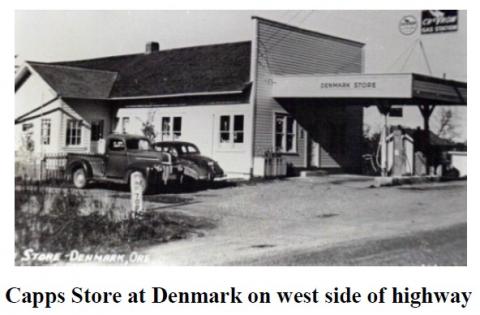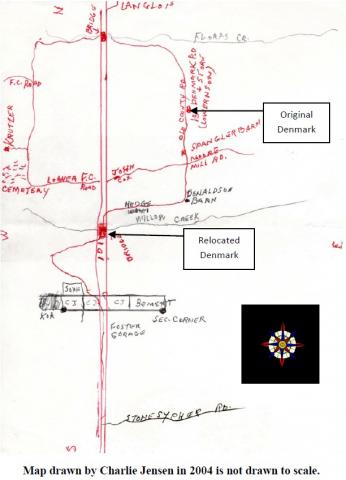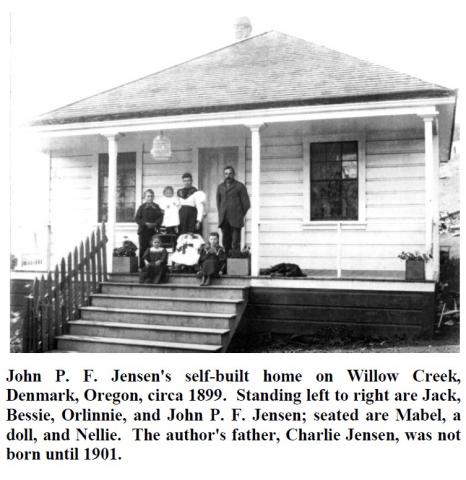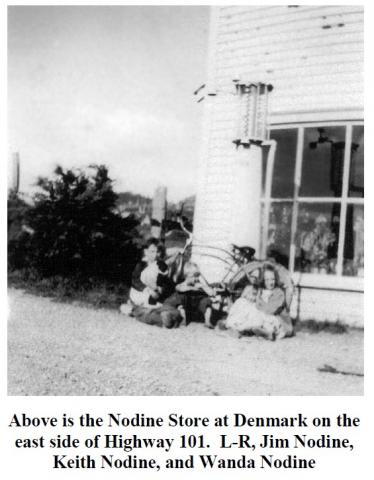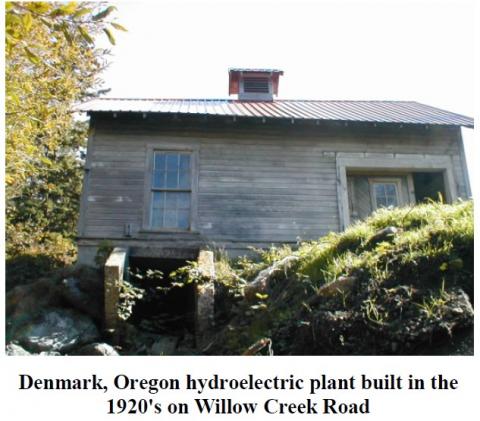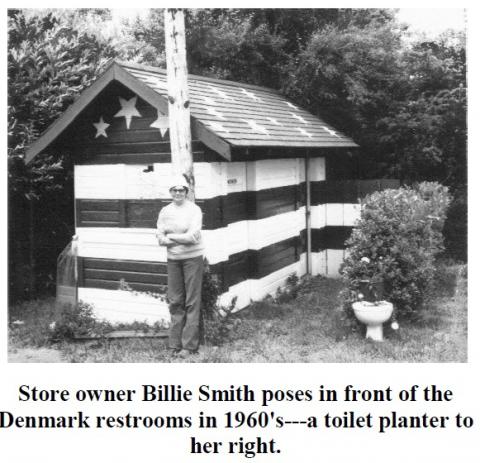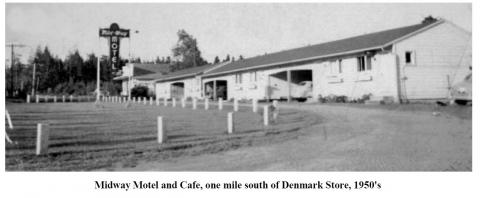Denmark, Oregon - Cousin to Langlois
(by Bonnie Jensen Cox)
There was a time when Langlois School (aka "Dairyville School") was referred to as the "north side school" to distinguish it from Denmark, Oregon's "south side school." That was in 1885 when Dairyville's school sat on the north bank of Floras Creek, and the community of Denmark was contained in its first location nearer Floras Creek than Willow Creek. Later, Langlois School would be moved inside the town's platted boundaries, and the focal point of Denmark would be adjacent to Willow Creek Bridge as articulated on a map that my father, Charlie Jensen, drew for me when he was 102. The relevance of the two communities to each other might suggest a cousin kinship.
Though early Denmark had its own schoolhouse and post office, plus a cheese-making industry and mercantile business that served the surrounding farm community, those services and commerce were eventually absorbed by Langlois. Before there were telephones in the area, one could leave a message at J. S. Capps' mercantile at Denmark and it would be delivered to its intended receiver whenever he or she came by for supplies that Edgar Capps had freighted from Bandon with his four-horse team. When there were residential telephones in the area, five to six households would share a multi-party line, listening for their particular ring pattern before answering the call. Our three-digit phone number in the 1950's was 268- one long ring followed by four shorts. If you wanted to make a long distance call to Port Orford or Bandon, you dialed "O" for operator assistance and could expect additional charges on your next phone bill.
Denmark, Oregon is on many maps, but there appears to be no map of Denmark, Oregon. Apparently it's a matter of mindset---you are from Denmark, Oregon if you think you are, or if the mail for your residence used to be routed through the little hamlet's post office. My father told me that the rural community that had been founded by Danish immigrants once contained as many as a couple hundred dwellers, but with no official boundaries to determine population counts, that number could have been either more or less. Growing up, our mailing address was Star Route, Denmark, Oregon---though it wasn't really necessary to include the "Star Route" business.
Like other like-minded Danes, my grandfather (Johan Peter Frederic Jensen), his parents and half-siblings left their homeland in Europe's Denmark so that they might homestead in Curry County, Oregon. They were drawn to the surrounds of a settlement called "Denmark" that had been founded by Nicholas Lorentzen circa 1881. Formerly a man of the sea, Lorentzen created an overnight stopping place for travelers. Also on the premises was a post office, and for awhile a small news office where J. S. Upton set type for The Southwest Recorder.
Some of the land was cleared using controlled burns, then plowed and seeded---horse and manpower accomplishing the finishing touches. To prove up on his claim, my grandfather built a dwelling on Willow Creek---even painted the finished house. It was my father's impression that Grandpa had salvaged the paint from the cargo of the Bawnmore that shipwrecked west of Denmark, Oregon in 1895.
Settlers built fences, sometimes to keep animals in, and other times to keep them out. Many of the farm roads in the area were gated at multiple intervals, and when one of my aunts lived on Willow Creek it was necessary to open and shut a half dozen wooden gates before arriving at her home.
My father received his formal education at Denmark School, while I received mine in Langlois, even though we spent most of our "growing up" years at the same physical address. Denmark's first public school was logbuilt, its locale near today's Lower Floras Lake Road and east of the Denmark Cemetery. It was later replaced by a vacated home that sat a short distance northeast of today's Jensen bluberry-cranberry bogs. That schoolhouse fell into such disrepair that it was suplanted by a new school built nearby. In 1928, Denmark School closed and its membership was absorbed by Langlois School District. By then bus transportation was available, Highway 101 had replaced the county road, and Langlois School had space available. Secondary roads like Airport and Floras Lake were still graveled in the 1950's, and students waiting for their morning transport might see the dust before they spotted the bus. My siblings and I rode the Brush Prairie bus, the route's name derived from prairie land in the vicinity of the nearby airport built in 1942. Many families built little "bus sheds" at the ends of their private roads and driveways in which children could wait for their rides, protected from the elements.
For awhile, the relocated Denmark, Oregon had two general stores---the Nodines running one on the east side of Highway 101, the Capps maintaining a mercantile in the former cheese factory across the road. I remember the store of the early 1950's when Quinns owned it, where you could buy licorice toothbrushes and candy cigarettes. Sodas were chilled in a free-standing cooler that had circulating cold water, the buyer wiping the chosen bottle down before paying 10 ten cents at the counter for a 16-ounce RC.
Denmark's store and post office burned in 1960. Charred debris marked the spot until Willie and Billie Smith of Nesika Beach bought the land and resurrected a gas station with living quarters behind. Billie took special pride in the patriotic restrooms she created from the two-door facilities that had survived the fire.
There was plenty of outdoor entertainment for children who had energy to burn when chores were finished. Families usually had a horse or two to ride (either saddled or bareback), barns had haymows stuffed with unbaled hay, one could swim or fish in Willow Creek, dangle a worm-baited line in Swanson Creek, build treehouses, or concoct makeshift rafts that could be poled across irrigation ponds. There were forests to explore and hunt, wild berries to harvest, and softly graded hills divided by creeks full of minnows, frogs, and waterdogs. The imaginative child could also play "ship" or "castle" on the various outcroppings of mica rock strewn throughout the area, and the young teen might stop by by Midway Café with adjacent motel (near today's KOA) where he or she could be sated with shuffle board, pinball machines, jukebox music, and fresh baked pies.
Denmark, Oregon…where family souls yet linger.
_______________________________________
Bonnie Jensen Cox is the author of two recently published books, "The Story Behind the Treble Clef, Family Roots in Denmark, Oregon," and "School Evolution, A Study of Southern Coos and Northern Curry School Origins."

